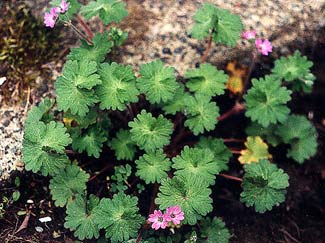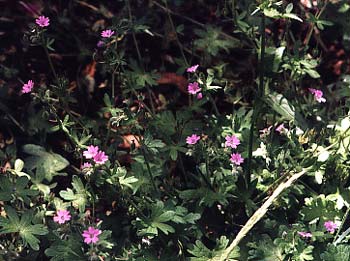 Dove's-foot Crane's-bill
Dove's-foot Crane's-bill
"You ought to put handles on that skull.
Maybe you could grow geraniums in it."
-said by Henry Fonda
in "The Lady Eve"
directed by Preston Sturges,
1941
in "The Lady Eve"
directed by Preston Sturges,
1941
Dove's-foot Crane's-bill is also rendered Dovesfoot Cranesbill, aka Dove's-foot Geranium. It is Geranium molle, originally a European wildflower, but so long naturalized in the United States it is found from coast to coast, & is very common here in the Pacific Northwest. It acts as if it has always been here, & is especially common west of the Cascades & all around Puget Sound & along the Columbia River. It must have come to America as a freeloader since it has never been widely cultivated (unlike, say, the pervasive dandylion which was brought to America by the Dutch for their vegetable gardens). There are many other wild geraniums in America but nearly all are originally from Europe.
The flowers of Dove's-foot Crane's-bill look like teency pink ten-petalled lilac-pink daisies, but if you look closely, they have "obdurate petals" meaning each petal looks like two, & if you plucked one of these petals, it is heart-shaped; there are really only five of these petals per flower. The name Crane's-bill or Cranesbill is derived from the fact that the pistil & calyx, once the flowers are spent, look like the heads of cranes. Erodiums are called "Storkesbill" for the same reason.
 Though it's an annual, it might as well be regarded as perennial it self-seeds in-place so reliably. In dry, clayey, roadside, & sun-exposed areas it tends to hug the ground quite closely & spread usually no larger than a saucer, sometimes to the size of a dinner plate. The above April photograph at the top of this page is not a cared-for specimen; rather, it's a portrait of a neglected volunteer growing in a bit of dust on the concrete rim of the sunken garage! It's stunted compared to the one in rich soil that gets watering under the rohani beach. or the one at the edge of a well-watered shade-garden in the second photograph taken in July. But even the stunty volunteer is quite attractive.
Though it's an annual, it might as well be regarded as perennial it self-seeds in-place so reliably. In dry, clayey, roadside, & sun-exposed areas it tends to hug the ground quite closely & spread usually no larger than a saucer, sometimes to the size of a dinner plate. The above April photograph at the top of this page is not a cared-for specimen; rather, it's a portrait of a neglected volunteer growing in a bit of dust on the concrete rim of the sunken garage! It's stunted compared to the one in rich soil that gets watering under the rohani beach. or the one at the edge of a well-watered shade-garden in the second photograph taken in July. But even the stunty volunteer is quite attractive. Along river edges, forest floors, or when fertilized & permitted to grow in gardens, it does not remain dinner-plate sized, but becomes much larger, a rangy bush that can creep around close to the ground like a vine, or stand one foot tall & spread two or three feet wide, seeding itself to spread wider & wider. It can spread into a rampant groundcover in nice conditions in the wild, but is very lightly rooted & easy to restrict a saved few specimens left behind when weeding the beds. The second photo shows the spreading groundcover capacity. Another one which we babied under the Rohani became a taller bushy type. You can see why many crane's-bill enthusiasts do end up with a special place in their hearts for these wild ones, which extend a collection of crane's-bills most delightfully.
People who want perfect lawns that look more like astroturf than anything alive will never tolerate this "nasty weed" because it easily spreads into turf, keeping its leaves low to evade being too mowed down. But it is sometimes offered in nursery catalogs, particularly by wildflower specialists (although given its ubiquity I would recommend just taking one from a roadside or ditch, or save & care for one that is already in the yard). Whoever delights in species wildflowers will be rewarded by feeding & encouraging a couple of these, discovering thereby the extreme edge of their beauty which is hardly less than any cultivar cranesbill.